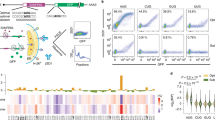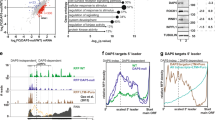Abstract
The human c-myc proto-oncogene is transcribed from four alternative promoters (P0, P1, P2, and P3) giving rise to mRNAs having 5′ leader sequences of various length. The c-myc P0 mRNA contains three open reading frames (ORFs), the last one encoding c-Myc1 and c-Myc2 proteins generated by alternative translation initiated at CUG and AUG codons. The middle ORF (MYCHEX1) and the 5′ ORF (ORF1) code for proteins 188 and 114 amino acids in length, respectively. We and others previously identified an internal ribosome entry site (IRES) in P0 and P2 c-myc mRNAs, promoting the cap-independent translation of c-Myc1 and c-Myc2. Here, we report the presence of a second IRES (named IRES1) promoting the cap-independent translation of MYCHEX1 in c-myc P0 mRNA. Using deletion analysis, we mapped an 80-nt region essential for IRES1 activity. c-myc P0 mRNA is thus the first eukaryotic polycistronic mRNA described for which translation initiation of two different open reading frames (MYCHEX1 and c-Myc1/c-Myc2) involves internal ribosome entry.
This is a preview of subscription content, access via your institution
Access options
Subscribe to this journal
Receive 50 print issues and online access
$259.00 per year
only $5.18 per issue
Buy this article
- Purchase on Springer Link
- Instant access to full article PDF
Prices may be subject to local taxes which are calculated during checkout






Similar content being viewed by others
References
Akiri G, Nahari D, Finkelstein Y, Le SY, Elroy Stein O, Levi BZ . 1998 Oncogene 17: 227–236
Ausubel FM, Brent R, Kingston RE, Moore DD, Seidman JG, Smith JA, Struhl K . 1995 Curr. Protoc. Molec. Biol. 31: 10–12
Bentley DL, Groudine M . 1986a Nature 321: 702–706
Bentley DL, Groudine M . 1986b Mol. Cell Biol. 6: 3481–3489
Bernstein J, Sella O, Le SY, Elroy Stein O . 1997 J. Biol. Chem. 272: 9356–9362
Blackwood EM, Lugo TG, Kretzner L, King MW, Street AJ, Witte ON, Eisenman RN . 1994 Mol. Biol. Cell 5: 597–609
Blyn LB, Swiderek KM, Richards O, Stahl DC, Semler BL, Ehrenfeld E . 1996 Proc. Natl. Acad. Sci. USA 93: 11115–11120
Blyn LB, Towner JS, Semler BL, Ehrenfeld E . 1997 J. Virol. 71: 6243–6246
Chappell SA, Edelman GM, Mauro VP . 2000 Proc. Natl. Acad. Sci. USA 97: 1536–1541
Corcoran L, Cory S, Adams J . 1985 Cell 40: 71–79
Cornelis S, Bruynooghe Y, Denecker G, Van Huffel S, Tinton S, Beyaert R . 2000 Mol. Cell 5: 597–605
Créancier L, Mercier P, Prats AC, Morello D . 2001 Mol. Cell. Biol. 21: 1833–1840
Dedieu JF, Gazin C, Rigolet M, Galibert F . 1988 Oncogene 3: 523–529
Eick D, Polack A, Kofler E, Lenoir GM, Rickinson AB, Bornkamm GW . 1990 Oncogene 5: 1397–1402
Gazin C, Rigolet M, Briand JP, Van Regenmortel MH, Galibert F . 1986 EMBO J. 5: 2241–2250
Gueydan C, Houzet L, Marchant A, Sels A, Huez G, Kruys V . 1996 Mol. Med. 2: 479–488
Hann SR, Dixit M, Sears RC, Sealy L . 1994 Genes Dev. 8: 2441–2452
Hann SR, King MW, Bentley DL, Anderson CW, Eisenman RN . 1988 Cell 52: 185–195
Hann SR, Sloan Brown K, Spotts GD . 1992 Genes Dev. 6: 1229–1240
Hellen CU, Witherell GW, Schmid M, Shin SH, Pestova TV, Gil A, Wimmer E . 1993 Proc. Natl. Acad. Sci. USA 90: 7642–7646
Henis-Korenblit S, Strumpf NL, Goldstaub D, Kimchi A . 2000 Mol. Cell Biol. 20: 496–506
Holcik M, Korneluk RG . 2000 Mol. Cell Biol. 20: 4648–4657
Holcik M, Lefebvre C, Yeh C, Chow T, Korneluk RG . 1999 Nat. Cell Biol. 1: 190–192
Hoover RG, Kaushal V, Lary C, Travis P, Sneed T . 1995 Curr. Top. Microbiol. Immunol. 194: 257–264
Huez I, Creancier L, Audigier S, Gensac MC, Prats AC, Prats H . 1998 Mol. Cell. Biol. 18: 6178–6190
Hunt SL, Hsuan JJ, Totty N, Jackson RJ . 1999 Genes Dev. 13: 437–448
Jackson RJ . 1988 Nature 334: 292–293
Johannes G, Sarnow P . 1998 RNA 4: 1500–1513
Kaminski A, Jackson RJ . 1998 RNA 4: 626–638
Kruys V, Thompson P, Beutler B . 1993 J. Exp. Med. 177: 1383–1390
Le SY, Maizel JV, Jr . 1997 Nucleic. Acids. Res. 25: 362–369
Marcu KB, Bossone SA, Patel AJ . 1992 Annu. Rev. Biochem. 61: 809–860
Nanbru C, Lafon I, Audigier S, Gensac MC, Vagner S, Huez G, Prats AC . 1997 J. Biol. Chem. 272: 32061–32066
Obaya AJ, Mateyak MK, Sedivy JM . 1999 Oncogene 18: 2934–2941
Pelletier J, Sonenberg N . 1988 Nature 334: 320–325
Prats AC, Vagner S, Prats H, Amalric F . 1992 Mol. Cell Biol. 12: 4796–4805
Pyronnet S, Pradayrol L, Sonenberg N . 2000 Mol. Cell 5: 607–616
Ray D, Robert Lezenes J . 1989 Oncogene Res. 5: 73–78
Ryan KM, Birnie GD . 1996 Biochem. J. 314: 713–721
Sella O, Gerlitz G, Le SY, Elroy-Stein O . 1999 Mol. Cell Biol. 19: 5429–5440
Spotts GD, Patel SV, Xiao Q, Hann SR . 1997 Mol. Cell. Biol. 17: 1459–1468
Spencer CA, LeStrange RC, Novak U, Hayward WS, Groudine M . 1990 Genes Dev. 4: 75–88
Stoneley M, Chappell SA, Jopling CL, Dickens M, MacFarlane M, Willis AE . 2000 Mol. Cell Biol. 20: 1162–1169
Stoneley M, Paulin FE, Le Quesne JP, Chappell SA, Willis AE . 1998 Oncogene 16: 423–428
Teerink H, Voorma HO, Thomas AA . 1995 Biochim. Biophys. Acta 1264: 403–408
Vagner S, Gensac MC, Maret A, Bayard F, Amalric F, Prats H, Prats AC . 1995a Mol. Cell Biol. 15: 35–44
Vagner S, Waysbort A, Marenda M, Gensac MC, Amalric F, Prats AC . 1995b J. Biol. Chem. 270: 20376–20383
Willis AE . 1999 Int. J. Biochem. Cell Biol. 31: 73–86
Yang Q, Sarnow P . 1997 Nucleic. Acids. Res. 25: 2800–2807
Acknowledgements
We thank Drs Hervé Prats and Cyril Gueydan for helpful discussions and for revising the manuscript. We thank JG Patton for sending the anti-PTB antibody. This work was funded by the EC Biotech Program (BIO4-CT95-0045), the Fund for Medical Scientific Research (Belgium, grant 3.4586.93), and the ‘Actions de Recherches Concertées' (grant 94–99/181). C. Nanbru was supported by a ‘Télévie’ grant.
Author information
Authors and Affiliations
Corresponding author
Rights and permissions
About this article
Cite this article
Nanbru, C., Prats, AC., Droogmans, L. et al. Translation of the human c-myc P0 tricistronic mRNA involves two independent internal ribosome entry sites. Oncogene 20, 4270–4280 (2001). https://doi.org/10.1038/sj.onc.1204548
Received:
Revised:
Accepted:
Published:
Issue Date:
DOI: https://doi.org/10.1038/sj.onc.1204548
Keywords
This article is cited by
-
Silencing the epigenetic silencer KDM4A for TRAIL and DR5 simultaneous induction and antitumor therapy
Cell Death & Differentiation (2016)
-
Upstream ORF affects MYCN translation depending on exon 1b alternative splicing
BMC Cancer (2009)
-
Identification of a panel of tumor-associated antigens from breast carcinoma cell lines, solid tumors and testis cDNA libraries displayed on lambda phage
BMC Cancer (2004)
-
Mapping and characterization of the minimal internal ribosome entry segment in the human c-myc mRNA 5′ untranslated region
Oncogene (2004)
-
The evolutionary dynamics of eukaryotic gene order
Nature Reviews Genetics (2004)



